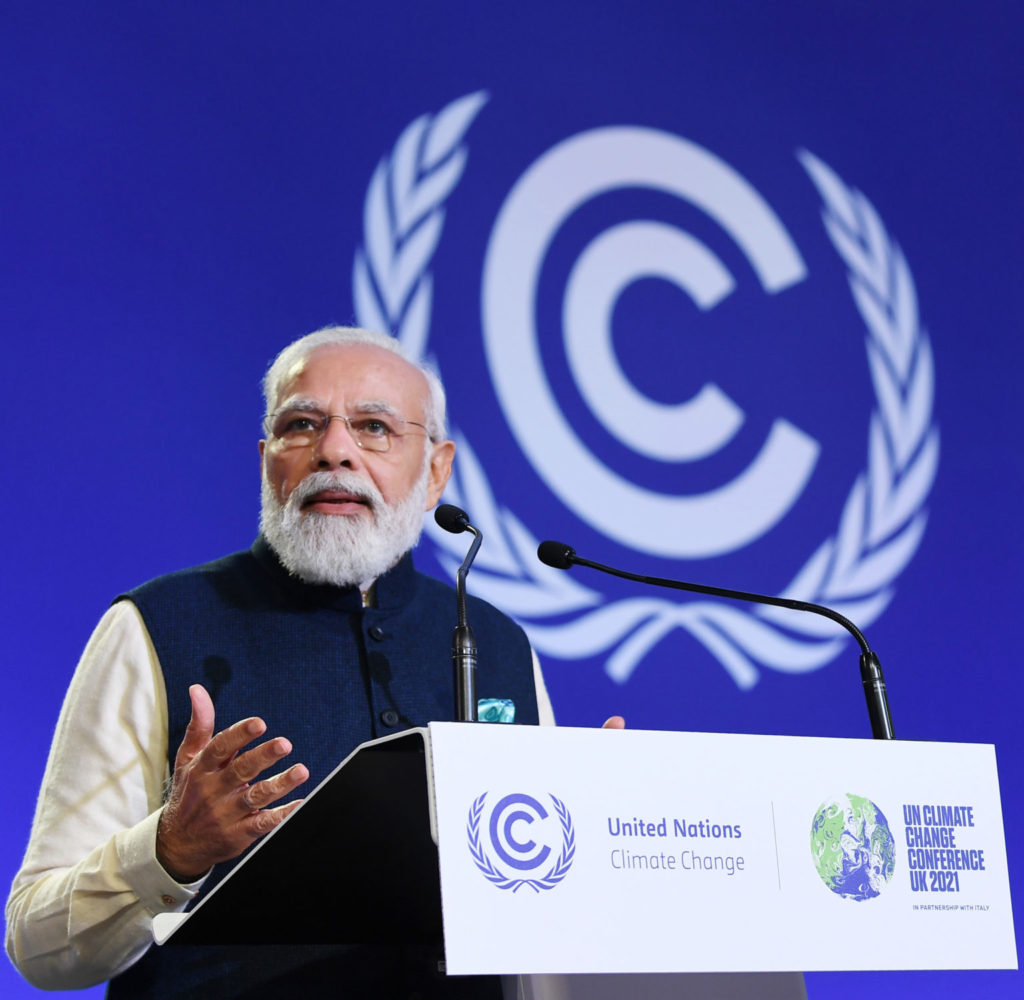
(Photo Credit: Government of India)
There are some hard truths in Modi’s speech
Speaking at COP26, India Prime Minister Narendra Modi said:
“It would be appropriate justice to create pressure on nations that don’t meet their own promises of climate finance. India expects developed nations to make climate finance of $1 trillion (per year) available at the earliest. Today it’s important to track climate finance just like we track the progress of climate mitigation. “
Modi also boasted that India is the only country working in “letter and spirit” on its commitments to combat climate change under the Paris Agreement.
Modi’s speech at COP 26 was ultimately one of the most notable talks for the event with three important takeaways:
1. Be Bold and Aspirational…(Within Limits)
Prime Minister Narendra Modi made a bold pledge (…well, at least, bold for India standards) by setting a net zero emissions target for 2070. The first-time target for India falls short of the goal at the COP26 summit to have all countries commit to net zero emissions by 2050.
India is the world’s third biggest emitter of carbon dioxide after China and the U.S…China and the U.S. committed to net zero emissions by 2060 and 2050 respectively. Thus, the world is looking to India to do more on climate change. But India’s massive population means its emissions per capita is lower than other big economies, i.e. 1.9 tonnes of CO2 per person in 2019 compared to 15.5 tonnes per person for the U.S.
Glasglow attendees may be disappointed by the target date for India….it is effectively 20 years late for some experts. Yet Modi got the attention of his countrymen back home with the promise. Alongside his net zero emissions promise, he committed India to tapping renewable resources for 50% of its energy and reducing total projected carbon emissions by one billion tonnes by 2030.
Modi made these declarations with a very strong caveat: rich countries need to pay for these climate goals thus his ask for $1 trillion solely for India by 2030, which is ten times the unmet $100 billion a year for all poor countries under previous deals. Rich countries have only been able to provide roughly $80 billion per year to date.
If the $100 billion has not arrived each year, then one can assume $1 trillion will not arrive…sounds like a “COP-out” for Modi.
2. The Cost for Net Zero Emissions is High…Not Clear Who Will Pay
The previous $100 billon promised by rich countries was high and aspirational (and unattainable in the eyes of some experts). The money also was only intended to fund decarbonization measures and infrastructure that helps protect against extreme weather events. Most importantly, the promise was not fully funded.
Speaking at COP26, former U.S. President Barack Obama emphasized the need for rich countries to act with urgency and pay the cash necessary for adaptation and resilience. Obama also discussed how too little progress had been made since the 2015 Paris Agreement. His criticism of China and Russia in the net zero emissions process had its irony as the U.S. abandoned the Paris Agreement during the presidency of Donald Trump. The U.S. has since re-entered the Paris Agreement during the presidency of Joe Biden, but the policy change between Trump and Biden only highlight how U.S. policy can change (without notice).
The sad truth is that the big three – U.S., China, and Russia – plus the European Union and the U.K. among other rich countries are not financially matching their publicized ambitions for the globe. India is simply the biggest country to highlight the lack of funds necessary to meet net-zero emissions by 2050. It also has many countries happy to tag-along or sit behind it with the hope of receiving additional financial support.
In short, it appears the rich countries (who emitted tonnes of carbon during their development years) are asking poorer countries to stop using coal among other things and cut emissions without a clarity on how leaders should pay for the reduction in emissions while also maintaining growth and development in their country.
It is only right that Modi (and others) ask who will fund the bill for poorer countries because it is odd (and unfair in the eyes of some observers) for leaders of developing countries to undercut their growth and development to offset emissions of the richer countries.
3. Asia is at the Center of COP26 and Climate Change…
Modi equally spoke for poorer countries and industrialized countries. Take coal which is a favorite villain in the battle against climate change. Asia (including Australia) produces and consumes about 75% of the world’s coal. About 75% of India’s power comes for coal while that number is 50% for China. Walking away from coal for Asia will not be easy…though success is largely dependent on only two countries—China and India—changing their coal habits.
Other richer Asian countries will have to make some changes too. Japan, for example, was indicated in leak documents to be among a group of countries lobbying for COP26 countries to reduce the emphasis on the need to move immediately away from fossil fuels. Australia was also in that group. South Korea, for example, admits it is behind other rich countries in reducing emissions and sounds worried about its ability to accelerate its process without undercutting various industries and hurting businesses and jobs.
Asian countries overall will struggle to change what has powered them for years. A shift from industrial countries powered by coal (or other villain-like resources) will have to become powered by green technology in the next decade. That is better said than done, especially for poorer countries awaiting financial support from richer countries.
At the end of the day, Modi may have appeared brash in his approach and his words…but that cannot overshadow the hard truths raised by his speech.
